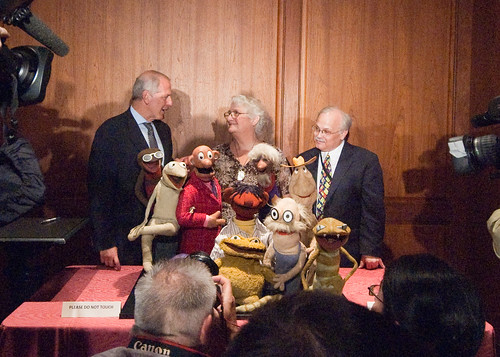
‘Jane Henson, Brent D. Glass, NMAH director, and Dwight Blocker Bowers, NMAH curator’
courtesy of ‘erin m’
Kermit the Frog and Oscar the Grouch have long been popular attractions at the Smithsonian’s National Museum of American History. On Wednesday morning, courtesy of a donation by Jane Henson and the rest of the Jim Henson family, they gained a few new fuzzy friends: the original puppets used in “Sam and Friends,” one of Jim Henson’s earliest TV projects.
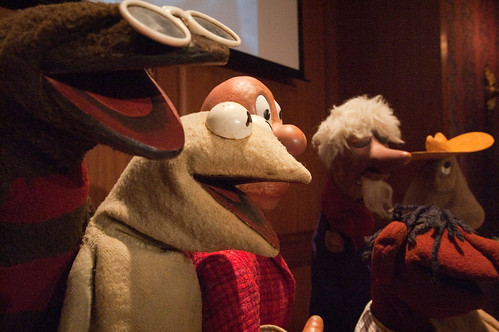
‘Kermit and friends’
courtesy of ‘erin m’
Washington has its fair share of natives who go off into the world to do good things, but few have the longevity and appeal of the characters created by Jim Henson. In the 1950s, as a teenager living in Hyattsville and later as a student at the University of Maryland, Henson found work at local TV stations creating puppets for children’s shows, learning from an incredibly early age how to earn laughter and smiles from an audience. DC audiences were his test tube for the kinds of characters, humor and storytelling that would come to define the Henson Company for millions of fans; one of the most notable and successful such creative projects was “Sam and Friends,” which ran from 1955-1961 on WRC-TV.
The main character of the show was Sam, a bald papier mache lip-syncing singer in a suit who bore an uncanny resemblance to Henson friend and fellow WRC employee Willard Scott. But the one who would become Henson’s star was a fuzzy, green not-quite-a-frog-yet character named Kermit, made from the fabric of Henson’s mother’s discarded winter coat. The Kermit on “Sam and Friends” looks familiar enough, with his ping pong ball eyes and lanky build, but he’s missing a couple of the later version’s key attributes: webbed feet, and the spiked collar. Kermit and Sam are joined by other characters in whom we can see other hints of the characters who would eventually populate Henson’s later projects: Pierre the French Rat, who looks an awful lot like Rizzo the Rat; Mushmellon, in whose grouchy face you can see the kernel that would eventually become Oscar; Yorick, a Shakespearean-themed purple skull with a happy enough expression that you can trace his evolution to Cookie Monster. In all, there are 10 puppets from the show who will be going on display in the museum’s pop culture gallery in November.
It is a bit of a homecoming for the characters. Jane Henson, museum Director Brent D. Glass and Curator Dwight Blocker Bowers all noted the local beginnings of the characters who would eventually take the world by storm. “I am sure these guys are really pleased to be home,” Henson said.
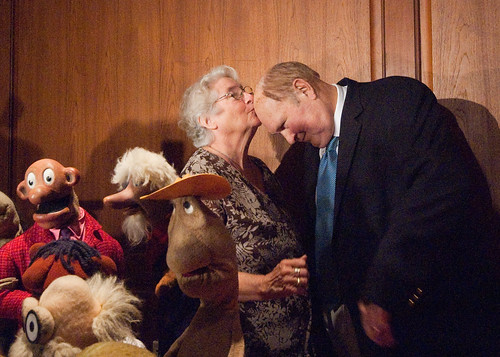
‘Jane Henson and Willard Scott’
courtesy of ‘erin m’
The Muppets and other characters are most identified with Jim Henson personally, and indeed 9 of these original puppets were made by Jim himself as a teenager (the 10th, Mushmellon, was made by Jane). Like so many great projects, though, the work was the result of a fruitful, lifelong collaboration between Henson, his wife, Jane, friends like Willard Scott, and the many, many other puppeteers and builders who worked with him from his teen years until his death in 1990. Jane Henson and Willard Scott were on hand for Wednesday’s donation ceremony, and watching them together was a charming glimpse into the creative energy that must have existed around these friends when they were getting their start with shows like “Sam and Friends.”
Looking back on the Henson legacy, Scott, himself no stranger to longevity, reflected on the enduring popularity of the “Sam and Friends” characters and the ones they would later inspire: “People come and go in TV, but not the Muppets,” Scott said. “They just went on and got better and better and better.”
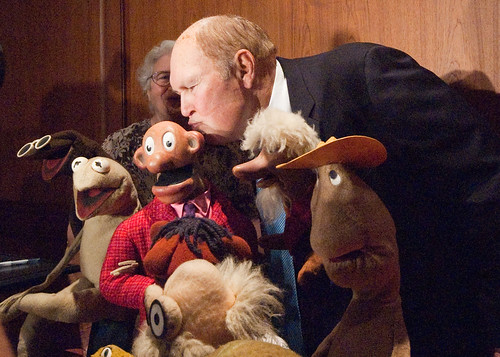
‘Sam and Willard Scott’
courtesy of ‘erin m’
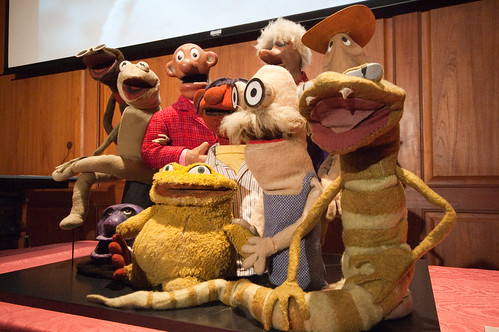
‘Sam and Friends’
courtesy of ‘erin m’

‘Sam and friends’
courtesy of ‘erin m’
Pingback: Anonymous
It was so interesting to learn about how “Sam & Friends” evolved into the Muppets. The ceremony must have been especially meaningful for Jane Henson & Willard Scott. The photos are wonderful.